“To Come After a Sonnet”
A very awkward sketch, ’tis true:
But since it is a sketch of you,
And because I made it, too
I like it here and there; –do you?
In the Introduction to The Penguin Book of the Sonnet, Phillis Levin expatiates on the form and tradition of the sonnet. By choosing to write a sonnet, Levin imagines a kind of contract between the artist and her medium, “As a highly focused form, the sonnet attracts contradictory artistic impulses; in choosing and succumbing to the form, the poet agrees to follow the rules of the sonnet, but that willing surrender releases creative energy” (xxxvii). The young poet, Marianne Moore, chooses to evoke this contract in one of her first poems for Bryn Mawr’s literary magazine but does not partake in it. Moore’s “To Come After a Sonnet” engages with canonical form of the sonnet without conforming her own art. “To Come After a Sonnet” demonstrates the poet’s thoughtful engagement with the creation of her own style as well as experimentation with the various techniques of prosody. By examining this poem more closely, we can see how it becomes a path to understanding the poet that emerged.
Moore’s poetry is often difficult to interpret, because like her nod to the sonnet tradition yet refusal of the form, she creates gaps where there should be bridges. Rather than leading her reader through a highly organized structure, Moore often lets her quotes hang freely so that the reader must discern the context. We are left as readers to provide the links of the piece, finding commonalities or ways to connect the poem. The more that Moore leaves disconnected, the more that the reader must become a member of new type of contract– one that involves poem, author, and reader. In “ The Art of Silence and the Forms of Women’s Poetry,” Hugh Kenner redefines Moore’s editing as a process to expand rather limit “to delete was for [Moore] a kind of creative act” (ctd. in Krammer 154). Later in career, Moore becomes known for her multiple copies of poems, often deleting much of the poem as she revises it. However, deletion must then encompass revision, substitution, and visual recognition. Kenner speaks to the thoughtfulness with which Moore “deleted.” Moore’s poems are filled with gaps by their ordering, their visual dimensionality, and their concepts. In leaving spaces for interpretation, the poems fashion a new type of readership. A readership that comes after traditional notions that the reader is not involved in the contract.
Through this exploration of “To Come After a Sonnet,” I aim to establish gaps, and then provide two opposed readings (READING A and READING B) to demonstrate the rich critical complexity they allow. To access these readings, click on the paragraphs which indicate there are comments. The two readings provide alternative interpretations of the gaps that I layout. The gaps are not merely spaces which are visual blanks on a page. Gaps create a cessation in thought, in visual lineation and in narrative succession. I find this especially true when reading Moore’s early poetry. Reader-response theorist, Wolfgang Iser ,defines gaps by explaining that they occur, “… whenever the flow is interrupted and we are led off in unexpected directions, the opportunity is given to bring us into play our own faculty for establishing connection—for filling in the gaps left by the text itself”(“Reception Theory” 299). The gaps in this particular poem by are both gaps that are left open as well as ones that Moore fills. By concluding the poem with an open- ended question, Moore breaks out of the room of the sonnet tradition and explicitly creates room for the reader. This question elicits a response, necessitating the reader’s active engagement with the poem. By reprieving the speaker of answering the question, Moore creates a gap of silence which she prompts the reader to fill.
We are aided by punctuation of the poem. The use of colon, semi-colon, and dashes coupled with the fact that the poem is a mere two sentences suggests that Moore’s use of punctuation visually constructs space. The last line of the poem, “I like it here and there; –do you?” uses both a semi-colon and a dash. The combination of such particular punctuation provides the essential reconstruction of the reader. The semi-colon completes the thought and connects the speaker to the reader, yet the dash indicates a space, pause, even gap before the question is posed. Through the allowance of space between the speaker and the reader, Moore theorizes about the reception of art and representation. By allowing space within the poem, she acknowledges that gaps of time and personal interpretation are inherent in the process of reading. The idea that Moore potentially creates and fills her own gaps through punctuation is crucial to the argument of each reading.
However, even with the concrete markers of punctuation, we are lead into a more abstract gap– questioning the temporal relation of art to its own traditions. She creates an epilogue to a poem that the reader has no prior knowledge of or access to. This concept creates a mystery for the reader and leaves him or her questioning what the sonnet prior to this poem contained. The title of the poem alludes to this evasive sonnet, but it is uncertain whether there actually is a particular sonnet Moore had in mind or if the poem made to stand as a universal commentary to the traditional love sonnet. We, as readers, are left to provide our own context–one that comes “after” the idea of the sonnet. To fashion this context we must think about how we classify art: is it enough that a poem be a “sketch” (line 1) or must the author strive to make it something more? As readers, asked directly by Moore to fashion our own notion of a poem. By providing our answer, we engage in the dialogue. We complete the “sketch” so that it is only by our participation that poem is completed.

